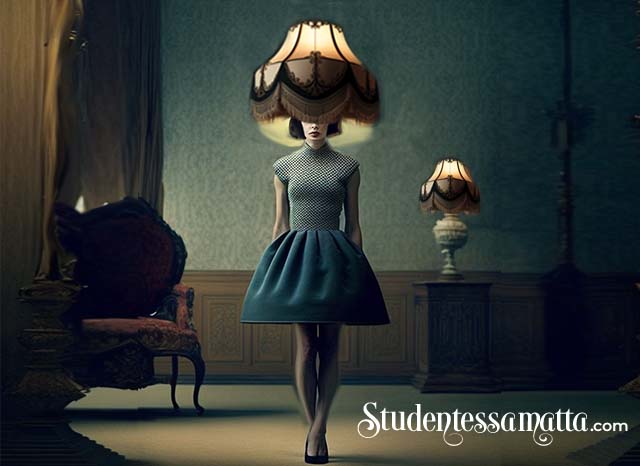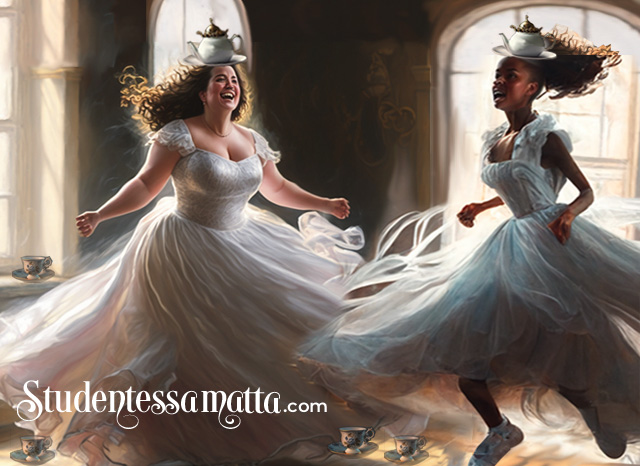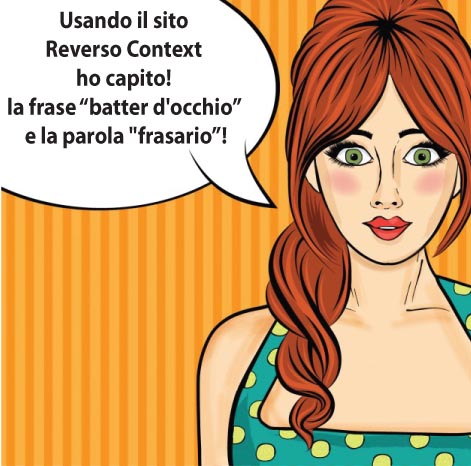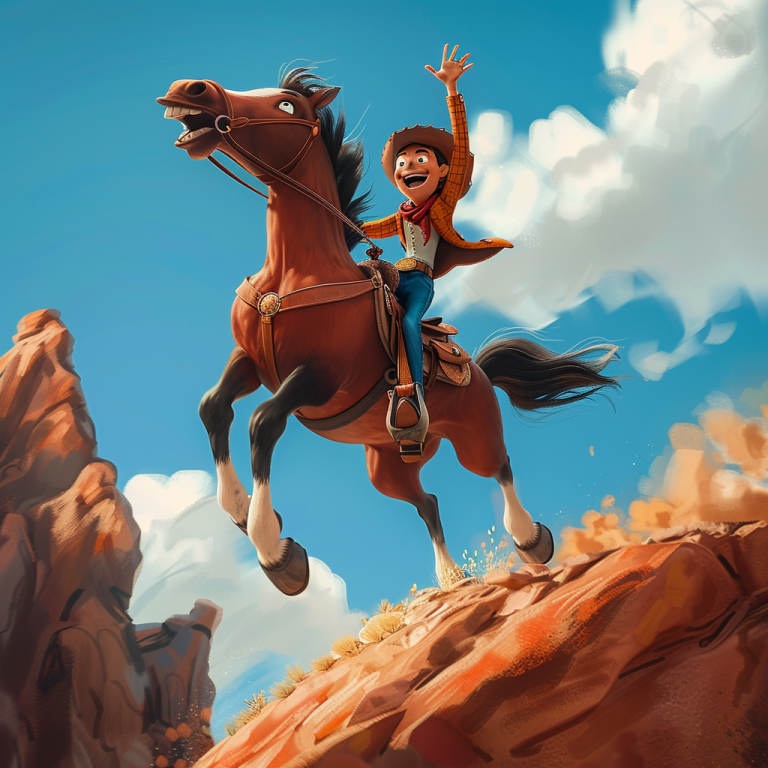
Image Credit: Studentessa Matta Illustration — Ragazza che bilancia una teiera sulla testa
Ascolta una registrazione di questo post in Italiano.
Listen a recording of this podcast in Italian.
Bilanciare una teiera sulla testa – cosa ha a che
fare con l’apprendimento delle lingue?
Niente, davvero!
Balancing a teapot on your head – what does it
have to do with language learning?
Nothing, really!
Ma se ci fosse un’immagine che incarnasse lo spirito della Studentessa Matta – beh, questo lo sarebbe!
But if there were an image that embodied the spirit of the Studentessa Matta — well, this would be it!
La ragazza con una teiera in testa ha una sorta di atmosfera da Alice nel paese delle meraviglie. È stravagante e assurda. Forse non riesci a capire cosa sta accadendo nel suo mondo e liquidarla come eccentrica e un’assurdità assoluta. In effetti, cose bizzarre e fantastiche che non si adattano perfettamente alle nostre scatole preconcette possono essere scomode. Eppure, se lasci entrare nuove idee e abbracci la follia, il divertimento e l’ironia, puoi essere trasformato e trasportato in posti nuovi.
The girl with a teapot on her head has a kind of Alice in Wonderland vibe. She is whimsical and absurd. Perhaps you might not understand what is happening in her world and dismiss it as eccentric and utter nonsense. Indeed, bizarre and fantastical things that don’t fit neatly into our preconceived boxes can be uncomfortable. And yet, if you let new ideas in and embrace the craziness, the fun, and the irony, you can be transformed and transported to new places.
Sii te stesso.
Esprimiti a modo tuo.
Vai un po’ matta ogni tanto!
Be yourself.
Express yourself in your own unique way.
Go a little crazy every now and then!

Ragazza con un paralume come cappello
Sfatiamo il mito che l’obiettivo di tutto è di essere perfettamente perfetto. Abbracciamo invece difetti e peculiarità (ci rendono più interessanti!)
Let’s debunk the myth that the goal of anything is to be perfectly perfect. Let’s embrace instead flaws and peculiarities (they make us more interesting!)
Essere capricciosa e spensierata, come la ragazza che indossa un paralume per e un cappello o quella che bilancia una teiera sulla testa, può portarci ad un approccio più rilassato e divertente alla vita. Queste ragazze potrebbero non avere sempre tutto sotto controllo. Tuttavia, sembra che siano aperte a nuove esperienze e sfide ed a loro non importa nulla che pensano gli altri.
Being capricious and carefree, like the girl who wears a lampshade hat or the one who balances a teapot on her head, can lead us to a more relaxed and fun approach to life. These nonconformists may not always have everything under control. However, they seem open to new experiences and challenges and don’t care what others think.
Quelli che non hanno paura di essere diversi non sono preoccupati di adattarsi alla folla o di seguire modelli impeccabili che indossano tiare che irradiano perfezione. Invece, creano i loro sentieri e vanno in direzioni diverse rispetto altri, perseguendo ciò che li rende veramente felici.
Those not afraid to be different aren’t worried about fitting in with the crowd or following flawless-tiara-wearing models who radiate perfection. Instead, they forge their own paths, go in different directions regarding others, pursuing what makes them truly happy.
Sanno che il perfezionismo è un obiettivo irraggiungibile. Non esiste. Seriamente! Non importa quello che fanno, ci saranno sempre altri che sono più intelligenti, più giovane, più figo, e più “qualcosa” di chi sono in questo momento. Si esauriscono e si deprimono solamente facendo confrontandosi inutile.
They know that perfectionism is an unobtainable goal. It doesn’t exist. Seriously! No matter what they do, there will always be others who are smarter, younger, hipper, and more “something” than who they are right now. They only exhaust and depress themselves by making futile comparisons.

Do you really want to be this plastically perfect? Let’s embrace flaws & peculiarities instead — after all, they make a more interesting picture and tell a much better story!
Quando impari una lingua, sforzarti di essere perfetto e confrontare i tuoi progressi con gli altri può anche essere una trappola pericolosa.
When learning a language, striving to be perfect and comparing your progress with others can also be a dangerous trap.
Quando si impara l’italiano, una mentalità perfezionista, può anche essere un vero guastafeste. Può succhiare il divertimento dal processo e trasformarlo in un lavoro noioso. Ogni studente di lingua commette errori e dimentica le parole o confonde la loro grammatica. Ma la verità, a volte, anche i madrelingua commettono errori. Figurati!
When learning Italian, a perfectionist mindset can also be a real buzzkill. It can suck the fun out of the process and turn it into a chore. Every language learner commits errors and forgets words or flubs their grammar. But truth be told, sometimes, even native speakers make mistakes. Imagine that!
Ognuno ha il proprio percorso quando si tratta di apprendimento delle lingue. Tutti devono lavorare sodo per imparare nuove parole, grammatica e preposizioni e mettere tutto insieme per fare conversazione. Ma solo perché Johnny può rotolare la sua R come un professionista e Sally sa già come coniugare l’imperfetto come un madrelingua, non significa che si dovrebbe sentire male per il proprio progresso. Tutti abbiamo i nostri punti di forza e di debolezza, che ci rendono unici. Fa tutto parte del processo di apprendimento. Quindi, qualunque sia il vostro livello in questo momento, va bene. L’importante è non arrendersi mai. Stabilisci obiettivi linguistici semplici da raggiungere e continua ad andare in avanti, anche se è centrimetro dopo centrimetro.
Everyone has their own journey when it comes to language learning. Everyone has to work hard to learn new words, grammar, and prepositions and combine them to make conversation. But just because Johnny can roll his R’s like a pro and Sally already knows how to conjugate the imperfect tense like a native speaker doesn’t mean you should feel bad about your own progress. We all have our strengths and weaknesses, which make us unique. It’s all part of the learning process. So, whatever level you are at right now, that’s okay. The important thing is not to give up. Set language goals that are easy to achieve and keep moving forward, even if it is inch by inch.

Ascolta la Studentessa Matta, e la ragazza che bilancia una teiera sulla sua testa e la ragazza con un paralume; Essere perfettamente perfetto è noioso. È meglio essere se stesso e seguire il proprio percorso. L’ apprendimento delle lingue dovrebbe essere divertente, spensierato, e delizioso. Vai al tuo ritmo, e continuare a praticare. Accetta i tuoi errori, festeggia i tuoi successi e non paragonare i tuoi progressi agli altri. E soprattutto, divertiti! Quando lo fai, si impara meglio!
Take it from Studentessa Matta, the girl balancing a teapot on her head, and the girl with a lampshade; being perfectly perfect is kind of boring. It’s better to be your own crazy self and walk your own path. Language learning should be fun, free-spirited, and delightful. Go at your own pace, and continue to practice. Embrace your mistakes, celebrate your successes, and don’t compare your progress to others. And most importantly, have fun! When you do, you learn better!













This post really hit home for me. Both me and my husband are learners of the italian language. At times I have found it difficult to learn and practice with him. I’m a structured, study type learner and he is a carefree, get to it when he can learner. What matters is that we are learning and continue to practice regardless of our different pace, ways of learning and our respective progress. I certainly will step up my “fun” game!
Ciao Giulia, Brava! sono contenta di leggere le tue parole! Everyone learns at different speeds and in different ways. Some are visual; some pick things up through auditory listening skills; some dissect and analyze grammar to intellectually understand all the puzzle parts to put it all together… embrace your learning style, create small achievable goals, and have fun! Un abbraccio! Melissa